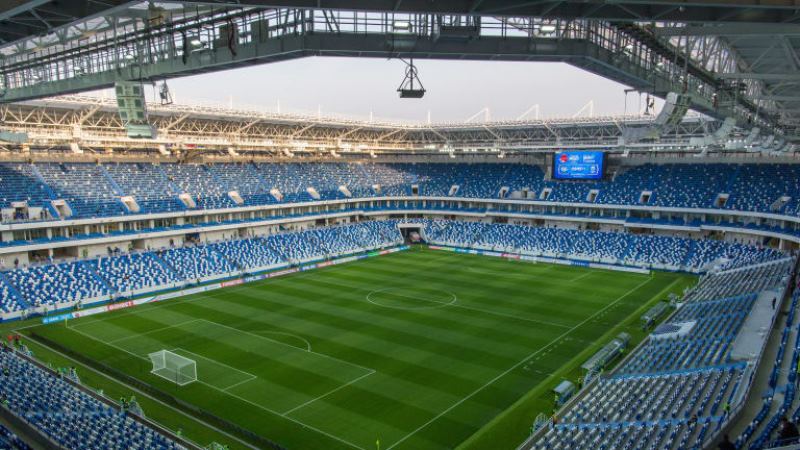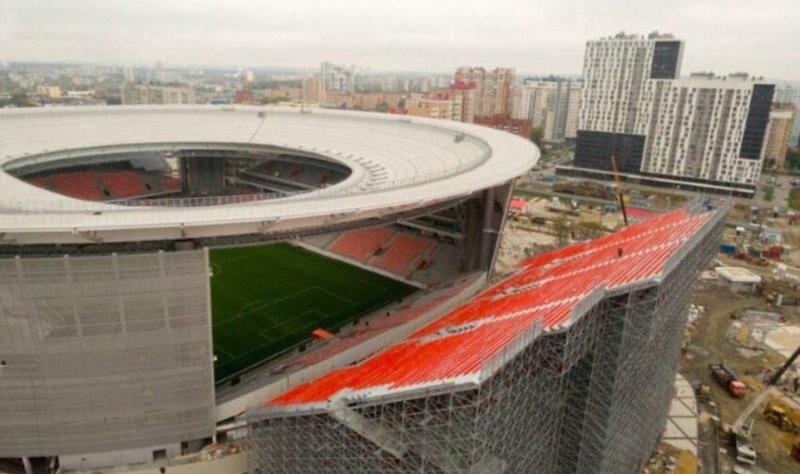
Russian President Vladimir Putin knows the legacy of his World Cup will be judged partly by the fate of the stadiums after the tournament and he is determined they are put to good use.
Russia has spent at least $4 billion (3.4 billion euros) on arena construction and refurbishments for the month-long showpiece.
Stunning venues rose from the ground in developed cities far from Moscow such as Nizhny Novogrod on the Volga River and in small and isolated places like Saransk.
Putin’s last TV phone-in show held a week before the tournament was unremarkable — until the moment he decided to underscore the importance of 12 stadium’s fate.
Russia’s dominant leader for most of the past two decades suddenly turned serious and even emotional. The regional bosses he was lecturing via video link froze behind their respective desks.
“I want to address colleagues from the regions,” Putin said.
“No matter what, you cannot allow these venues to turn into some sort of markets like those in the mid-1990s.”
The idea of Moscow’s Luzhniki Stadium becoming the go-to destination for second-hand clothes might puzzle fans lucky enough to have tickets for Sunday’s final between Croatia and France.
The 80,000-seat arena will be the focus of global attention and packed to the rafters.
But this will be Luzhniki on its good day.
The venerable crucible of Soviet sport entered the era of Russia’s independence in the 1990s looking scruffy and bleeding cash.
The country was mired in poverty and the only way to pay for Luzhniki’s upkeep was by parcelling off space to fly-by-night merchants who set up stalls across its vast grounds.
It stood as the unsightly symbol of Russia’s problems until being torn down in 2011 and lavishly rebuilt as the focus of the World Cup.
While Luzhniki’s future as the national stadium is probably safe, it is the subsistence model that places such as Saransk and Samara are forced to consider as they inherit grand stadiums that will be home to teams that draw a few thousand fans.
– Putin’s promise –
The stadiums that start to resemble Luzhniki as it was in the 1990s will remind locals of the sums Putin splurged showing off how his Russia could stage the most complex event in the world.
Ones that help develop football and the neighbourhoods around them will be remembered as historic turning points.
A spin around the 11 host cities suggests that most of the 12 arenas are destined to struggle — at least at first.
Only six have teams playing in the Premier League that fans are willing to pay money to watch.
FC Mordovia Saransk have been promoted from third-tier status to the more respectable second division to help fill the stands.
The Black Sea resort of Sochi did not even have a team until being assigned one last month that usually played before a couple of hundred determined supporters in Saint Petersburg.
The move was orchestrated by one of Putin’s wealthy childhood friends.
Average attendance in the lower FNL division where five World Cup stadium teams play was 2,029 last season.
Premier League matches have been drawing 12,000-13,000 and all but two of the new and rebuilt arenas have at least 44,000 seats.
“When we were designing our stadium, we were planning to include many options for making it commercially viable,” said Samara’s sports minister Dmitry Shlyakhtin.
“Right now, we do not fully understand how this can be done.”
– Missing millions –
Regional authorities told the Kommersant business daily that running all the new and rebuilt facilities will cost up to $100 million a year.
The federal government intends to allocate around $200 million to help teams and local officials cover the costs.
But that money will be paid out over five years and also be used for youth football development and other expenses.
Few provincial bosses think it will be enough — and not many analysts see a quick fix.
Industry experts say the appeal of being inside new stadiums boosts tickets sales slightly and for only a matter of years.
The US engineering firm AECOM is confident about the arena it designed for Spartak Moscow in which five World Cup matches were played.
It is less certain how a place like Saransk intends to fill its 45,000-seater.
“It is very difficult to see how such stadium capacities can be economically sustainable without major changes in the supporter demographic,” AECOM said in a research note.
– Seeking solutions –
Putin’s unusual ban on flea markets shot down the idea reportedly being considered by Saransk governor Vladimir Volkov.
The Kremlin has said nothing about Nizhny Novgorod’s proposal to convert a part of its venue into a medical clinic.
Kaliningrad intends to create a free-trade zone around its arena while Yekaterinburg is taking down the soaring temporary extensions that jutted out of the stadium and accounted represents Russia’s attempt to fix past World Cup excesses in places such as Brazil and South Korea that left disused arena scattered in their wake.
AECOM thinks the investment’s wisdom will ultimately be determined not by football but by how Russia’s economy and broader “geopolitical circumstances” fair. – Agence France-Presse

































